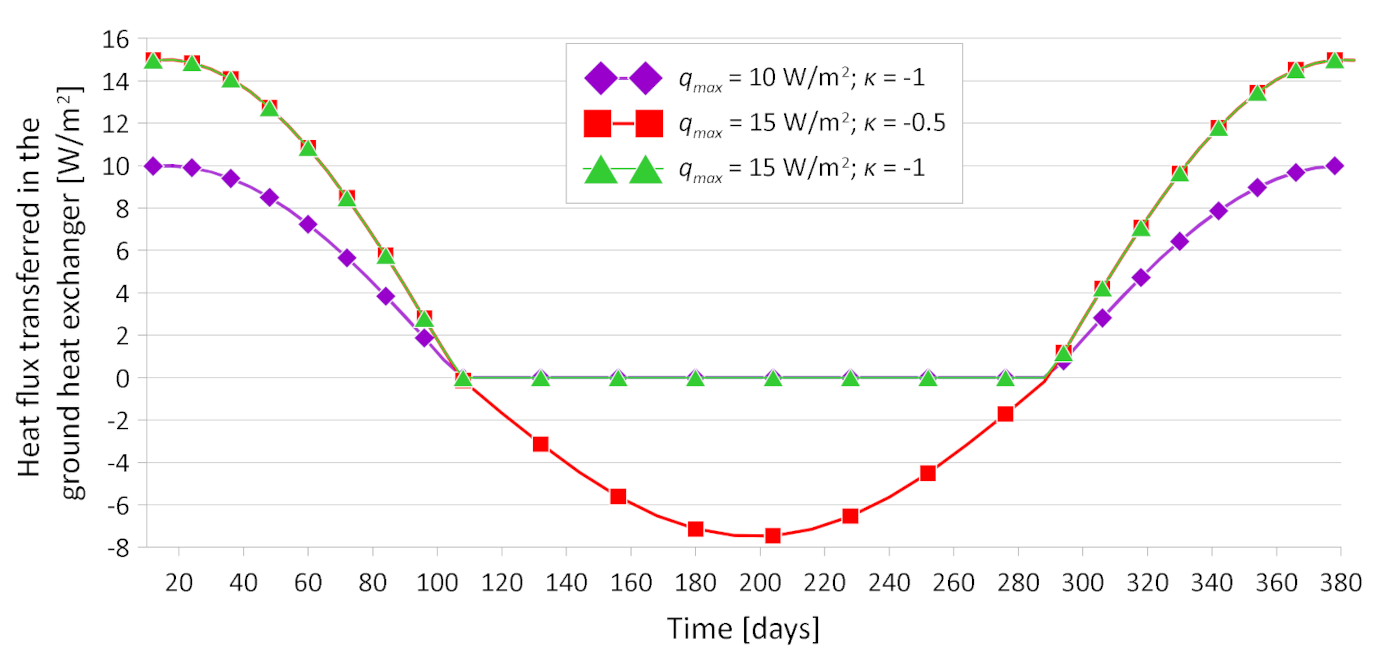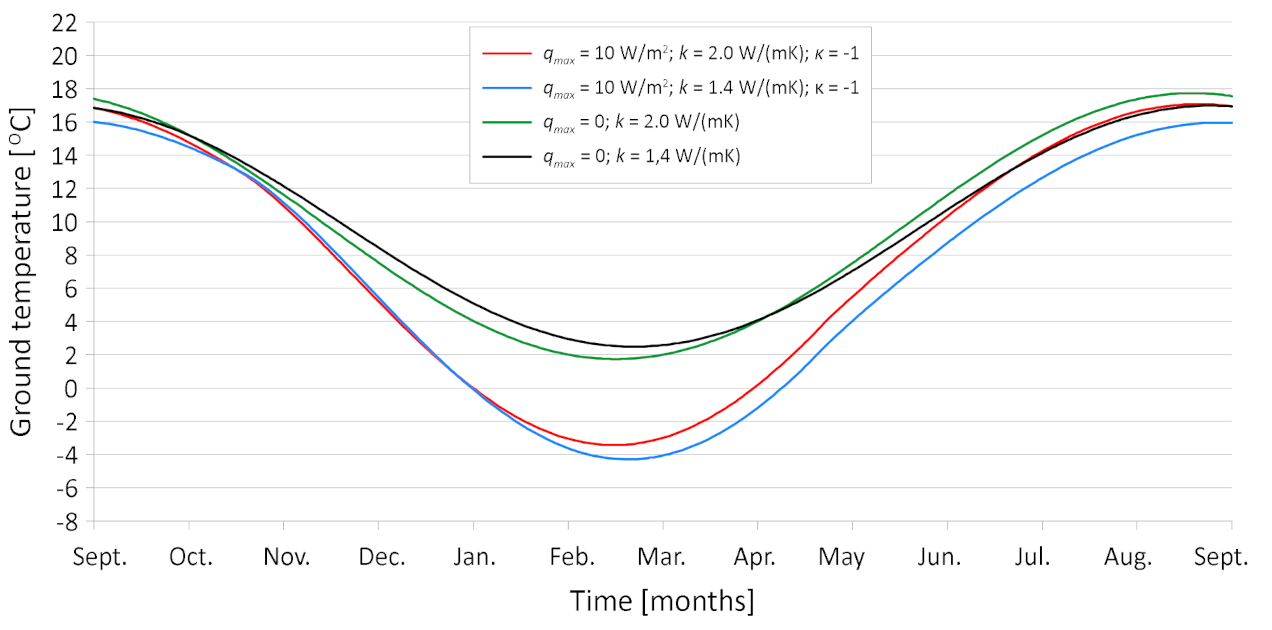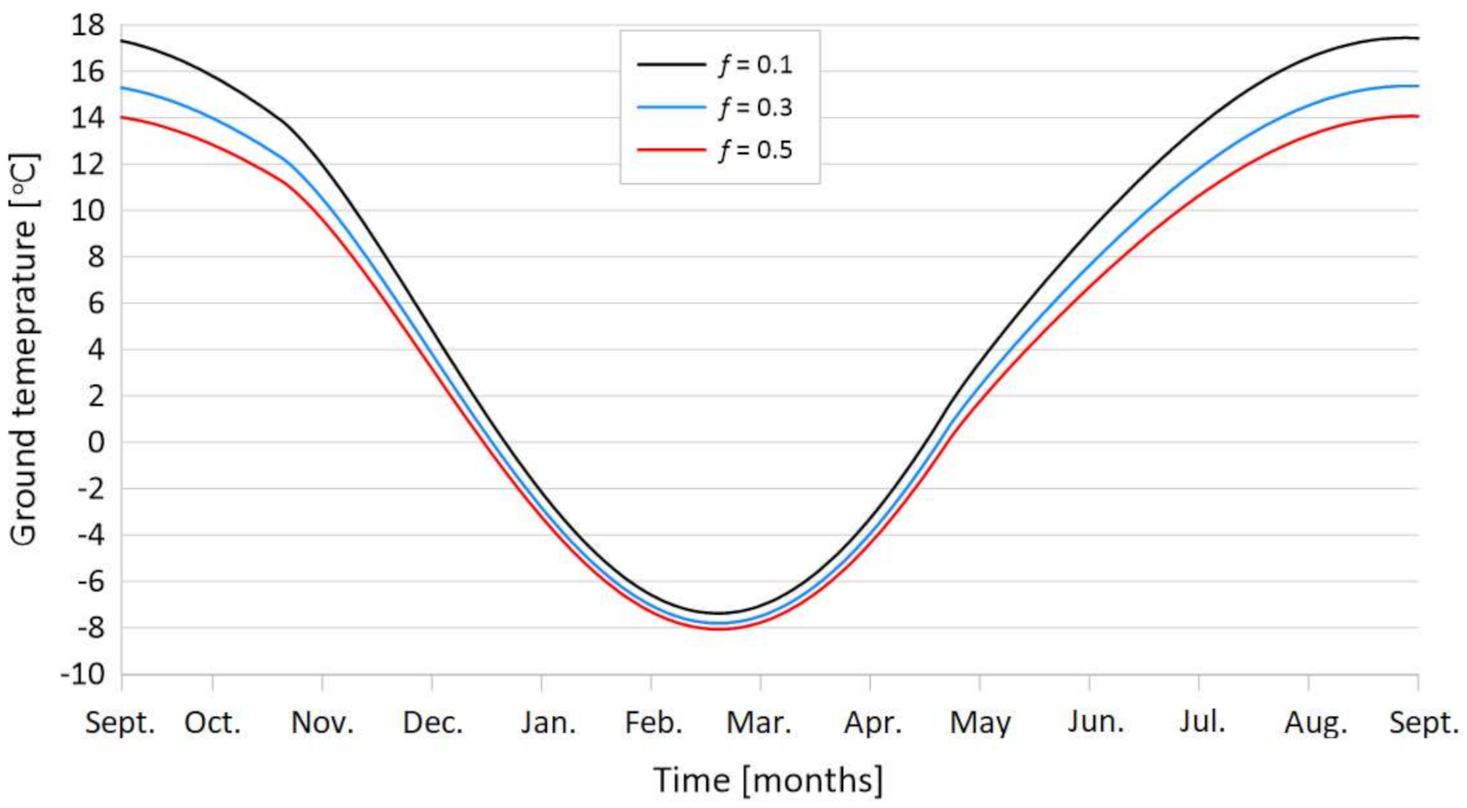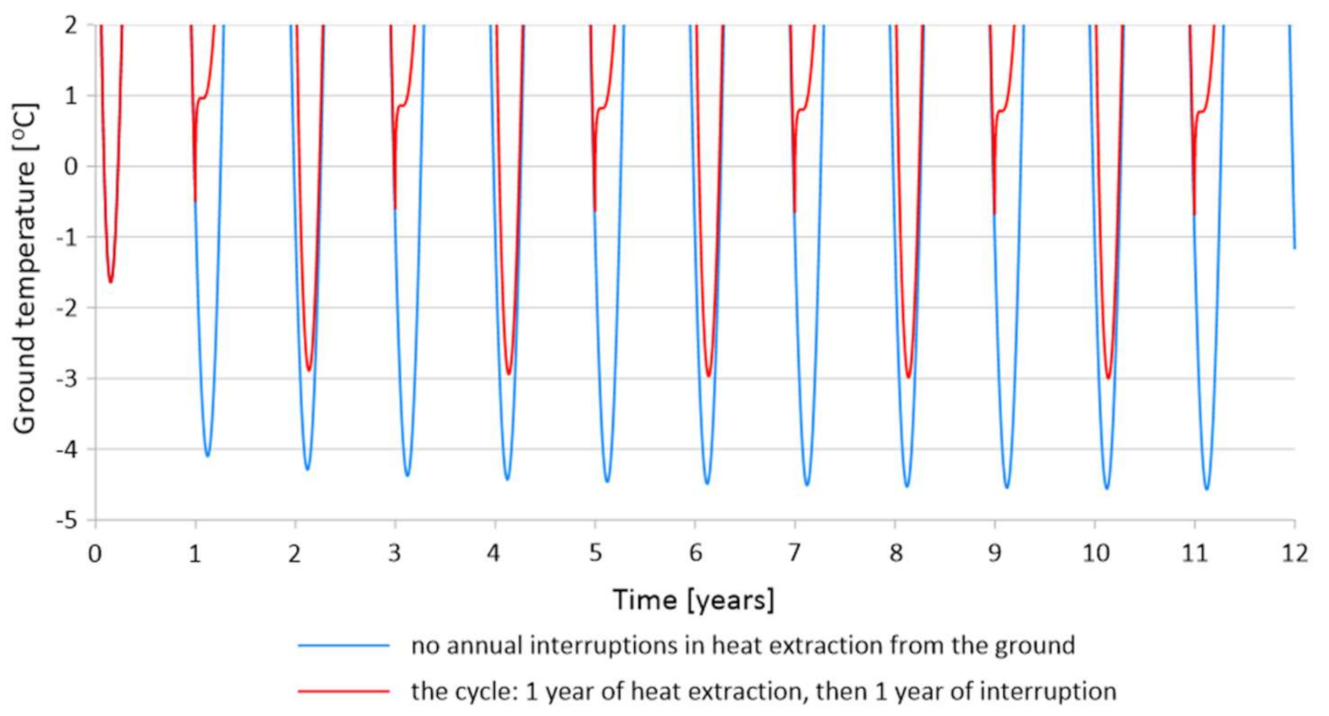Numerical Analysis of Minimum Ground Temperature for Heat Extraction in Horizontal Ground Heat Exchangers
Abstract
:1. Introduction
2. Mathematical Model
2.1. Sol-Air Evaporation Temperature
2.2. Heat Flux Transferred in the Exchanger
- During the heating period, a heat flux whose maximum value is is extracted from the ground and during summer the heat is not supplied to the ground: ;
- During the heating period, a heat flux whose maximum value is is extracted from the ground and during summer the heat is not supplied to the ground: ;
- During the heating period, a heat flux whose maximum value is is extracted from the ground and during summer the heat is supplied to the ground in an amount corresponding to .
2.3. One-Dimensional Model of Heat Conduction in the Ground
3. Results and Discussion
3.1. Ground Temperature Profiles
- During the heating period, a heat flux whose maximum value is is extracted from the ground and during summer the heat is not supplied to the ground: ;
- During the heating period, a heat flux whose maximum value is is extracted from the ground and during summer the heat is not supplied to the ground: ;
- During the heating period, a heat flux whose maximum value is is extracted from the ground, and during summer the heat is supplied to the ground in an amount corresponding to ;
- No heat exchanger is installed in the ground.
3.2. Time Series of Ground Temperature
3.3. Investigation of the Impact of Interruptions in Exchanger Operation
- The cycle: 1 year of heat extraction, then 1 year of interruption;
- No annual interruptions in heat extraction from the ground.
4. Conclusions
Author Contributions
Funding
Institutional Review Board Statement
Informed Consent Statement
Data Availability Statement
Conflicts of Interest
Nomenclature
| Symbols: | |
| constant , Pa/K | |
| amplitude of ambient temperature, K | |
| amplitude of ground surface temperature, K | |
| amplitude of solar heat flux, W/m2 | |
| constant , Pa | |
| volumetric heat capacity of the ground, J/(m3K) | |
| constant , K/Pa | |
| evaporation rate coefficient | |
| convective heat transfer coefficient, W/(m2K) | |
| distance between the heat exchanger and the surface of the ground, m | |
| maximum ground depth at which calculations are performed , m | |
| non-negative number | |
| ground thermal conductivity, W/(mK) | |
| long-wave radiation heat flux, W/m2 | |
| number corresponding to the depth at which the ground heat exchanger is installed | |
| number of points for which numerical calculations were performed | |
| parameter in definition equation of sol-air-evaporation temperature | |
| parameter in definition equation of sol-air-evaporation temperature | |
| phase angle of ambient, rad | |
| phase angle of the ground surface, rad | |
| phase angle of solar radiation, rad | |
| heat flux transferred between the surrounding and the surface of the ground, W/m2 | |
| heat flux transferred in the ground heat exchanger, W/m2 | |
| maximum heat flux transferred in the ground heat exchanger, W/m2 | |
| heat generation rate per unit volume, W/m3 | |
| amount of heat supplied to the ground in the summer period, J | |
| amount of heat extracted from the ground during the heating season, J | |
| relative humidity of ambient air | |
| solar radiation flux absorbed by the ground, W/m2 | |
| annually-averaged solar radiation flux absorbed by the ground, W/m2 | |
| time, s | |
| temperature, °C | |
| ambient temperature, °C | |
| annually-averaged ambient temperature, °C | |
| ground surface temperature, °C | |
| annually-averaged ground surface temperature, °C | |
| sol-air-evaporation temperature, °C | |
| position coordinate in the ground, m | |
| Greek symbols: | |
| thermal diffusivity of the ground, m2/s | |
| emissivity of the ground surface | |
| parameter characterizing the relationship between the amount of heat extracted and supplied from/to the ground | |
| frequency , 1/day | |
References
- Hossein, J.; Seyed, A.; Mohsen, P.; Zaboli, M. Performance analysis of helical ground heat exchangers with different configurations. Appl. Therm. Eng. 2019, 154, 24–36. [Google Scholar]
- Pan, A.; Lin, L.; Tian, Y. A new analytical model for short vertical ground heat exchangers with Neumann and Robin boundary conditions on ground surface. Int. J. Therm. Sci. 2020, 152, 106326. [Google Scholar] [CrossRef]
- Zhao, J.; Wang, H.; Li, X.; Dai, C. Experimental investigation and theoretical model of heat transfer of saturated soil around coaxial ground coupled heat exchanger. Appl. Therm. Eng. 2008, 28, 116–125. [Google Scholar] [CrossRef]
- Cai, B.; Li, H.; Hu, Y.; Liu, L.; Huang, J.; Lazzaretto, A.; Zhang, G. Theoretical and experimental study of combined heat and power (CHP) system integrated with ground source heat pump (GSHP). Appl. Therm. Eng. 2017, 127, 16–27. [Google Scholar] [CrossRef]
- Li, R.; Ooka, R.; Shukuya, M. Theoretical analysis on ground source heat pump and air source heat pump systems by the concepts of cool and warm exergy. Energy Build. 2014, 75, 447–455. [Google Scholar] [CrossRef]
- Widiatmojo, A.; Gaurav, S.; Ishihara, T.; Yasukawa, K.; Uchida, Y.; Yoshioka, M.; Tomigashi, A. Using a capillary mat as a shallow heat exchanger for a ground source heat pump system. Energy Build. 2020, 209, 109684. [Google Scholar] [CrossRef]
- Li, W.; Li, X.; Peng, Y.; Wang, Y.; Tu, J. Experimental and numerical studies on the thermal performance of ground heat exchangers in a layered subsurface with groundwater. Renew. Energy 2020, 147, 620–629. [Google Scholar] [CrossRef]
- Kapıcıoğlu, A.; Essen, H. Experimental investigation on using Al2O3/ethylene glycol-water nano-fluid in different types of horizontal ground heat exchangers. Appl. Therm. Eng. 2020, 165, 114559. [Google Scholar] [CrossRef]
- Garoosi, F.; Hoseininejad, F.; Rashidi, M.M. Numerical study of heat transfer performance of nanofluids in a heat exchanger. Appl. Therm. Eng. 2016, 105, 436–455. [Google Scholar] [CrossRef]
- Rashidi, M.M.; Nasiri, M.; Shadloo, M.S.; Yang, Z. Entropy generation in a circular tube heat exchanger using nanofluids: Effects of different modelling approaches. Heat Transf. Eng. 2017, 38, 853–866. [Google Scholar] [CrossRef]
- Li, W.; Dong, J.; Wang, Y.; Tu, J. Numerical modeling of a simplified ground heat exchanger coupled with sandbox. Energy Procedia 2017, 110, 365–370. [Google Scholar] [CrossRef]
- Monzó, P.; Puttige, A.R.; Acuña, J.; Mogensen, P.; Cazorla, A.; Rodriguez, J.; Montagud, C.; Cerdeira, F. Numerical modeling of ground thermal response with borehole heat exchangers connected in parallel. Energy Build. 2018, 172, 371–384. [Google Scholar] [CrossRef] [Green Version]
- Gan, G. A numerical methodology for comprehensive assessment of the dynamic thermal performance of horizontal ground heat exchangers. Therm. Sci. Eng. Prog. 2019, 11, 365–379. [Google Scholar] [CrossRef]
- Krarti, M.; Lopez-Alonzo, C.; Claridge, D.E.; Kreider, J.F. Analytical model to predict annual soil surface temperature variation. J. Sol. Energy Eng. 1995, 117, 91–99. [Google Scholar] [CrossRef]
- Khatry, A.K.; Sodha, M.S.; Malik, M.A.S. Periodic variation of ground temperature with depth. Sol. Energy 1978, 20, 425–427. [Google Scholar] [CrossRef]
- Givoni, B.; Katz, L. Earth temperatures and underground buildings. Energy Build. 1985, 8, 15–25. [Google Scholar] [CrossRef]
- Mihalakakou, G. On estimating soil surface temperature profiles. Energy Build. 2002, 34, 251–259. [Google Scholar] [CrossRef]
- Zhang, L.; Zhang, Q.; Huang, G. A transient quasi-3D entire time scale line source model for the fluid and ground temperature prediction of vertical ground heat exchangers (GHEs). Appl. Energy 2016, 170, 65–75. [Google Scholar] [CrossRef]
- Larwa, B.; Kupiec, K. Heat transfer in the ground with a horizontal heat exchanger installed—Long-term thermal effects. Appl. Therm. Eng. 2020, 164, 114539. [Google Scholar] [CrossRef]
- Kayaci, N.; Demir, H. Numerical modelling of transient soil temperature distribution for horizontal ground heat exchanger of ground source heat pump. Geothermics 2018, 73, 33–47. [Google Scholar] [CrossRef]
- Yang, W.; Kong, L.; Chen, Y. Numerical evaluation on the effects of soil freezing on underground temperature variations of soil around ground heat exchangers. Appl. Therm. Eng. 2015, 75, 259–269. [Google Scholar] [CrossRef]
- El-Din, M.M.S. On the heat flow into the ground. Renew. Energy 1999, 18, 473–490. [Google Scholar] [CrossRef]
- Lazzari, S.; Priarone, A.; Zanchini, E. Long-term performance of BHE (borehole heat exchanger) fields with negligible groundwater movement. Energy 2010, 35, 4966–4974. [Google Scholar] [CrossRef]
- Neiß, J. Ground as a heat source. In Proceedings of the German 134 Meeting of the Haus der Technik e.V. on Non-Conventional Energy Carriers, Essen, Germany, 21 March 1977. [Google Scholar]
- Wypych, A.; Piotrowicz, K. Air humidity in Cracow in the period 1863–2007—daily data quality control and homogenization methods. In Proceedings of the Sixth Seminar for Homogenization and Quality Control in Climatological Databases, Climate Data and Monitoring, Budapest, Hungary, 26–30 May 2008; pp. 60–67. [Google Scholar]
- Larwa, B. Heat Transfer Model to Predict Temperature Distribution in the Ground. Energies 2019, 12, 25. [Google Scholar] [CrossRef] [Green Version]
- McAdams, W.H. Heat Transmission; McGraw-Hill: New York, NY, USA, 1954; ISBN 978-0070447998. [Google Scholar]
- Allen, R.G.; Pereira, L.S.; Raes, D.; Smith, M. Crop Evapotranspiration-Guidelines for Computing Crop Water Requirements. 1998. Available online: http://www.fao.org/3/X0490E/x0490e00.htm#Contents (accessed on 18 April 2021).










| Quantity | Quantity Symbol | Value |
|---|---|---|
| Annually averaged ambient temperature | ||
| Amplitude of ambient temperature | ||
| Phase angle of ambient | ||
| Annually averaged solar radiation flux absorbed by the ground | ||
| Amplitude of solar heat flux | ||
| Phase angle of solar radiation | ||
| Relative humidity of ambient air | 0.79 | |
| Long-wave radiation heat flux | ||
| Evaporation rate coefficient | ||
| Distance between the heat exchanger and the surface of the ground | ||
| Volumetric heat capacity of the ground | ||
| Convective heat transfer coefficient |
| Quantity | Quantity Symbol | Value |
|---|---|---|
| Annually averaged ambient temperature | ||
| Amplitude of ambient temperature | ||
| Phase angle of ambient | ||
| Annually averaged solar radiation flux absorbed by the ground | ||
| Amplitude of solar heat flux | ||
| Phase angle of solar radiation | ||
| Ground thermal conductivity | ||
| Long-wave radiation heat flux | ||
| Parameter characterizing the relationship between the amount of heat extracted and supplied from/to the ground | ||
| Distance between the heat exchanger and the surface of the ground | ||
| Volumetric heat capacity of the ground | ||
| Maximum heat flux transferred in the ground heat exchanger |
Publisher’s Note: MDPI stays neutral with regard to jurisdictional claims in published maps and institutional affiliations. |
© 2021 by the authors. Licensee MDPI, Basel, Switzerland. This article is an open access article distributed under the terms and conditions of the Creative Commons Attribution (CC BY) license (https://creativecommons.org/licenses/by/4.0/).
Share and Cite
Leski, K.; Luty, P.; Gwadera, M.; Larwa, B. Numerical Analysis of Minimum Ground Temperature for Heat Extraction in Horizontal Ground Heat Exchangers. Energies 2021, 14, 5487. https://doi.org/10.3390/en14175487
Leski K, Luty P, Gwadera M, Larwa B. Numerical Analysis of Minimum Ground Temperature for Heat Extraction in Horizontal Ground Heat Exchangers. Energies. 2021; 14(17):5487. https://doi.org/10.3390/en14175487
Chicago/Turabian StyleLeski, Krystian, Przemysław Luty, Monika Gwadera, and Barbara Larwa. 2021. "Numerical Analysis of Minimum Ground Temperature for Heat Extraction in Horizontal Ground Heat Exchangers" Energies 14, no. 17: 5487. https://doi.org/10.3390/en14175487






